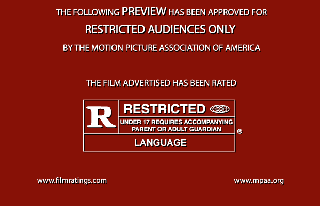The New York Times issued a piece on Tuesday covering the annual CinemaCon. This particular convention is basically a giant board meeting for theaters across the nation. They get together and come up with ideas to combat various problems (i.e. piracy, attendance, etc.) and the studios show up in force to shock & awe them with all of their upcoming product that will hopefully make both parties a lot of money over the coming year. Occasionally stars will make an appearance, as Brad Pitt did this year to stump for World War Z.
One of the big issues on NATO (National Association of Theater Owners)’s list this year was what they perceive as a glut of non-family friendly product. The president of the organization called for Hollywood to back off on R-rated product and produce more family-oriented fare instead, citing the fact that attendance numbers are down so far this year: “Make more family-friendly films and fewer R-rated titles…Americans have stated their choice.”. The Time then went on to point out that many of the films that the studios were promoting at the convention are R-rated and brought up the recent school shootings and the incident in Aurora, Colorado last year. That’s all good and fine, but a prime opportunity was missed here.
Are Americans fed up with R-rated movies? The numbers disagree with both NATO* and the picture that the Times was seemingly attempting to paint. The country isn’t avoiding adult-oriented fare any more than it is family-oriented fare.
WRATH OF THE TITANS (2012)
- Rated: PG-13
- Budget: $150 million
- Gross: $84 million
DARK SHADOWS (2012)
- Rated: PG-13
- Budget: $150 million
- Gross: $80 million
JOHN CARTER (2012)
- Rated: PG-13
- Budget: $250 million
- Gross: $73 million
BATTLESHIP (2012)
- Rated: PG-13
- Budget: $209 million
- Gross: $65 million
TOTAL RECALL (2012)
- Rated: PG-13
- Budget: $125 million
- Gross: $59 million
THE BOURNE LEGACY (2012)
- Rated: PG-13
- Budget: $125 million
- Gross: $113 million
PARANORMAN (2012)
- Rated: PG
- Budget: $60 million
- Gross: $56 million
FRANKENWEENIE (2012)
- Rating: PG
- Budget: $39 million
- Gross: $35 million
RISE OF THE GUARDIANS (2012)
- Rated: PG
- Budget: $145 million
- Gross: $103 million
JACK THE GIANT SLAYER (2013)
- Rated: PG-13
- Budget: $195 million
- Gross: $63 million
Granted some of these broke even or legitimately became profitable from their release abroad, but that is a subject for another day. The above films amount to a domestic loss of almost $620 million and that isn’t even factoring in their marketing and distribution costs…or the countless other studio projects that lost money at the box office since January 1st, 2012. Ouch.
On the flipside, the likes of Ted, Django Unchained, Silver Linings Playbook, 21 Jump Street, Safe House, Magic Mike, Argo, Zero Dark Thirty, Olympus Has Fallen, Identity Thief, and Sinister have all done well for themselves recently and are R-rated. Ted was one of the biggest hits of 2012 and the inevitable sequel will likely follow suit. The National Association of Theater Owners is right. America has voted. They have opted to avoid films that don’t interest them. Some of the films that have crashed and burned at the box office over the past year haven’t deserved it. Others absolutely have. What do we take away from this? That ratings do not factor here. Bad marketing is a factor, but not the main issue. The actual message is that Americans are becoming increasingly tired of half-assed big budget films, be they family-friendly or not.
As a commenter stated earlier today, instead of asking for less R-rated features, the theaters owners should be asking for better quality G/PG/PG-13 ones. Family-friendly fare will always make more money than adult-oriented projects. That’s just a fact and one that theater owners are well aware of. They also tend to play longer. If an R-rated film tanks, it’s gone within a couple weeks and its no skin off anyone’s back but those who paid for and starred in it. If a big budget family film falls on its face, it falls hard and the results can be bloody for studios and theaters. The more family members there are rolling in each weekend, the more money they make. Many don’t realize that theaters make very little money off of ticket sales, particularly during the first month of any film’s release. We’re talking as low as 25 cents a ticket for those first few weeks. Concession sales are their bread and butter, hence the 75%+ mark-up.
Instead of focusing on product that they can’t control (movies/ticket sales), theater owners should be focusing on what they can: their food and their property. Offer a greater selection and better variety of snacks and beverages. Make renovations and aesthetic changes as things begin to wear down and become dated. If you keep the food flying and your establishment looking nice, you just might be surprised at how it affects your business in the long run. Make your place of business an enjoyable one to visit and people…no matter their age or genre preference…will be FAR more likely to leave the comfort of their homes for a few hours to escape into the world of cinema.
Source | The New York Times
* – Come on guys, we really couldn’t pick a better name that didn’t piggy back off of a vastly more important group?
